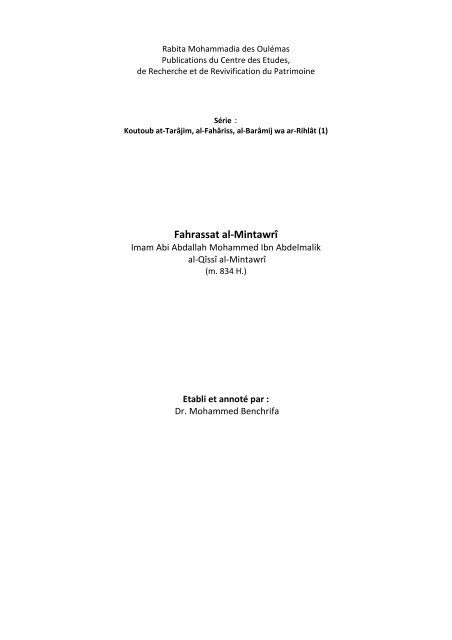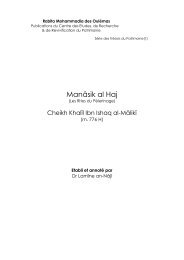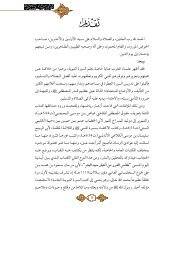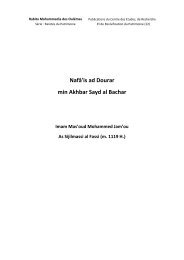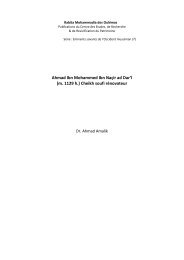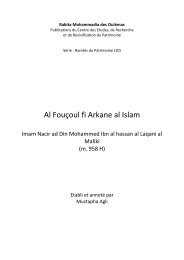Fahrassat al-Mintawrî
Fahrassat al-Mintawrî
Fahrassat al-Mintawrî
You also want an ePaper? Increase the reach of your titles
YUMPU automatically turns print PDFs into web optimized ePapers that Google loves.
Rabita Mohammadia des Oulémas<br />
Publications du Centre des Etudes,<br />
de Recherche et de Revivification du Patrimoine<br />
Série :<br />
Koutoub at-Tarâjim, <strong>al</strong>-Fahâriss, <strong>al</strong>-Barâmij wa ar-Rihlât (1)<br />
<strong>Fahrassat</strong> <strong>al</strong>-<strong>Mintawrî</strong><br />
Imam Abi Abd<strong>al</strong>lah Mohammed Ibn Abdelm<strong>al</strong>ik<br />
<strong>al</strong>-Qîssî <strong>al</strong>-<strong>Mintawrî</strong><br />
(m. 834 H.)<br />
Etabli et annoté par :<br />
Dr. Mohammed Benchrifa
<strong>Fahrassat</strong> <strong>al</strong>-<strong>Mintawrî</strong><br />
Imam Abi Abd<strong>al</strong>lah Muhammad Ibn Abdelm<strong>al</strong>ik <strong>al</strong>-Qîssî <strong>al</strong>-<strong>Mintawrî</strong><br />
(m. 834 H)<br />
Fahâris, as well as ithbât and barâmîj, are considered as a kind of writing in<br />
which North African and And<strong>al</strong>usian Ulemas have <strong>al</strong>ways excelled and were distinct<br />
from their Eastern peers. When we study the content of these fahâris we observe<br />
that most of them focus on the cheykhs [of the authors of fahâris] and on the titles<br />
of the books they learnt from them by listening, reading or by other ways of<br />
transmission. Fahâris were part of or<strong>al</strong> teaching programs, like glossaries, poetry or<br />
prose.<br />
One of the aspects of the interest of North African and And<strong>al</strong>usian Ulemas for this<br />
kind is that anyone of them who professed in writing wrote a fahrassa. However, in<br />
spite of the great number of fahâris, most of them are lost. In order to save what<br />
can be saved, the Patrimony Reviv<strong>al</strong>, Research and Studies Centre of the<br />
Muhammadan League of Religious Scholars has begun the study, the annotation and<br />
the publication of the rare fahâris available in libraries. The Centre begins the fahâris<br />
series by the important fahrassa of the [Quran] reciting, the Hadîth speci<strong>al</strong>ist, Imam<br />
Abi Abd<strong>al</strong>lah Muhammad Ibn Abdelm<strong>al</strong>ik <strong>al</strong>-Qîssî <strong>al</strong>-<strong>Mintawrî</strong> (d. 834 H.). This<br />
fahrassa, containing a big number of books titles, indicates the continuity of scientific<br />
references conserved by And<strong>al</strong>usians and the permanence of scientific communication<br />
between North Africa and the East. This fahrassa is very important because it is<br />
very rich and useful. On the style level it looks like the fahrassa of Ibn Khayr <strong>al</strong>-<br />
Ishbîli (d. 575 H).<br />
The fahrassa of <strong>al</strong>-<strong>Mintawrî</strong>, the one of Abi Zakaria as-Serraj (d. 805 H.), <strong>al</strong>-<br />
Barnâmaj of Abi Abd<strong>al</strong>lah <strong>al</strong>-Majârî (d. 862 H.), ar-Rihla of Abi <strong>al</strong>-Hassan <strong>al</strong>-<br />
Q<strong>al</strong>sâdî (d. 891 H.), that contains his fahrassa, as well as the manuscript of Abi<br />
ja’far Ahmad Ibn Ali <strong>al</strong>-B<strong>al</strong>wî <strong>al</strong>-Uâdî Ashî (d. 938 H.) are considered as the last<br />
episodes the fahâris series in And<strong>al</strong>usia.<br />
Translation: Mekaoui Abdélilah
<strong>Fahrassat</strong> <strong>al</strong>-<strong>Mintawrî</strong><br />
Imam Abi Abd<strong>al</strong>lah Mohammed Ibn Abdelm<strong>al</strong>ik <strong>al</strong>-Qîssî <strong>al</strong>-<strong>Mintawrî</strong><br />
(m. 834 H)<br />
Les fahâris, ainsi que les ithbât et les barâmij, sont considérés comme un genre<br />
d’écriture dans lequel les Oulémas du Maghreb et de l’And<strong>al</strong>ousie ont de tout temps<br />
excellé et dans lequel ils se sont distingués de leurs semblables orientaux. En<br />
étudiant le contenu de ces fahâris, on constate que la plupart sont axés sur les<br />
cheikhs [des auteurs des fahâris] et sur les titres des livres qu’ils ont appris de ces<br />
derniers par l’écoute, la lecture, ou par d’autres voies de transmission. Ce genre<br />
faisait partie, au même titre que les lexiques, la poésie ou la prose des programmes<br />
d’enseignement or<strong>al</strong>.<br />
Un des aspects de l’intérêt des Oulémas du Maghreb et de l’And<strong>al</strong>ousie pour ce<br />
genre est que toute personne qui professait dans l’écriture en rédigeait à un moment<br />
ou à un autre. Néanmoins, en dépit de leur grand nombre, la plupart de ces fahâris<br />
ont été perdues. Afin de sauvegarder ce qui peut l’être, le Centre des Etudes, de<br />
Recherche et de Revivification du Patrimoine de la Rabita Mohammadia des Oulémas<br />
s’est attelé à l’étude, l’annotation et la publication des rares fahâris disponibles dans<br />
les bibliothèques. Le Centre entame la série des fahâris par l’importante fahrassa du<br />
récitant [du Coran], spéci<strong>al</strong>iste du Hadîth, l’Imam Abi Abd<strong>al</strong>lah Mohammed Ibn<br />
Abdelm<strong>al</strong>ik <strong>al</strong>-Qîssî <strong>al</strong>-<strong>Mintawrî</strong> (m. 834 H.). Cette fahrassa, contenant un grand<br />
nombre de titres d’ouvrages relatifs à de nombreux arts et sciences, nous indique la<br />
continuité des références scientifiques que les And<strong>al</strong>ous conservaient et la permanence<br />
de la communication scientifique entre les Maghrébins et les Orientaux. Cette fahrassa<br />
est très importante, car elle est très fournie et très utile. Par le style, elle ressemble<br />
à la fahrassa de Ibn Khayr <strong>al</strong> <strong>al</strong>-Ishbîli (m. 575 H.).<br />
La fahrassa d’<strong>al</strong>-<strong>Mintawrî</strong>, ainsi que celle de Abi Zakaria as-Serraj (m. 805 H.),<br />
<strong>al</strong> Barnâmaj de Abi Abd<strong>al</strong>lah <strong>al</strong>-Majârî (m. 862 H.), ar Rihla de Abi <strong>al</strong>-Hassan<br />
<strong>al</strong>-Q<strong>al</strong>çâdî (m. 891 H.), qui comprend sa fahrassa, ainsi que le manuscrit de Abi<br />
Ja’far Ahmad Ibn Ali <strong>al</strong>-B<strong>al</strong>wî <strong>al</strong>-Ouâdî Ashî (m. 938 H.) sont considérés comme<br />
les derniers épisodes de la série des fahâris en And<strong>al</strong>ousie.<br />
Traduction : Mekaoui Abdélilah


